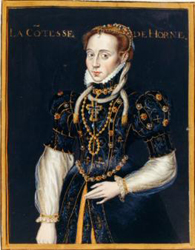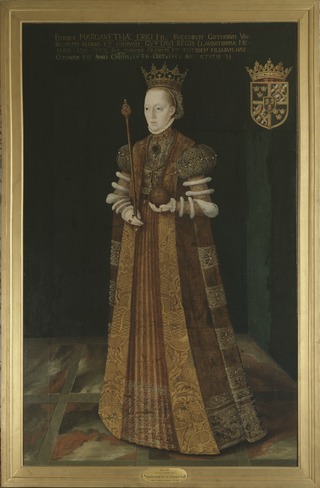
Margaret Leijonhufvud or Margareta Eriksdotter was Queen of Sweden from 1536 to 1551 by marriage to King Gustav I. She played a political role as the advisor of, and the intermediary to, her spouse the King.

Anna Pavlovna of Russia was Queen of the Netherlands by marriage to King William II of the Netherlands. She was a Russian patriot who upheld a strict royal etiquette in the Netherlands, where she never felt at home, and identified more as an Imperial Russian grand duchess than a Dutch queen. She had no political influence, but was active within charity.
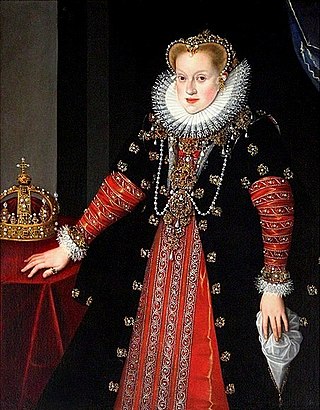
Anne of Austria was Queen of Poland and Sweden as the first consort of King Sigismund III Vasa.

Maria Josepha of Austria was the Queen of Poland and Electress of Saxony by marriage to Augustus III. From 1711 to 1717, she was heiress presumptive to the Habsburg monarchy. Her sister Maria Amalia became Electress of Bavaria.

Maria Anna of Spain was a Holy Roman Empress and Queen of Hungary and Bohemia by her marriage to Ferdinand III, Holy Roman Emperor. She acted as regent on several occasions during the absences of her husband, notably during his absence in Bohemia in 1645.
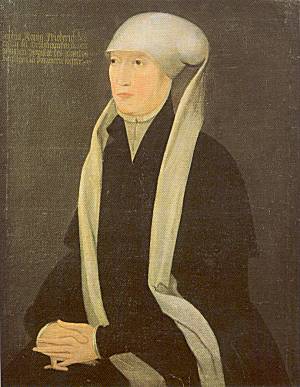
Sophie of Pomerania (1498–1568) was Queen of Denmark and Norway as the spouse of Frederick I. She is known for her independent rule over her fiefs Lolland and Falster, the castles in Kiel and Plön, and several villages in Holstein as queen.

Anna Vasa of Sweden was a Swedish princess heavily involved in the politics of that country and of Poland. She was starosta of Brodnica and Golub. The youngest child of King John III of Sweden and Catherine Jagiellon, she was close to her brother Sigismund Vasa, King of Poland (1587–1632) and King of Sweden (1592–99). Raised a Catholic, Anna converted to Lutheranism in 1584. Though she had several suitors, she remained unmarried.

Duchess Anna of Prussia and Jülich-Cleves-Berg was Electress consort of Brandenburg and Duchess consort of Prussia by marriage to John Sigismund, Elector of Brandenburg. She was the daughter of Albert Frederick, Duke of Prussia, and Marie Eleonore of Cleves.

Catherine Vasa of Sweden was a Swedish princess, and the Countess consort of East Frisia as the spouse of Edzard II, Count of East Frisia. She was the oldest daughter of Gustav Vasa and Margareta Leijonhufvud. She was the autonomous Regent of Berum and Norden in Ostfriesland from 1599 to 1610.

Princess Sophia of Sweden, also Sofia Gustavsdotter Vasa, was a Swedish princess, daughter of King Gustav Vasa of Sweden and Margareta Leijonhufvud. She was formally Duchess consort of Saxe-Lauenburg by her marriage to Duke Magnus II of Saxe-Lauenburg.
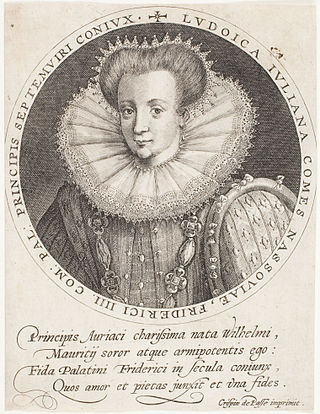
Louise Juliana of Orange-Nassau was a countess consort of the Palatinate by marriage to Frederick IV, Elector Palatine, and took part in the regency government of her son between 1610 and 1614. She also acted as a mediator between the king of Sweden and the elector of Brandenburg in 1631.
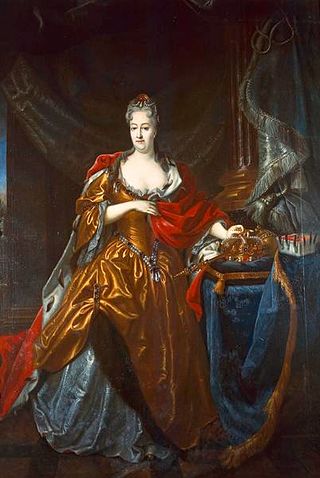
Christiane Eberhardine of Brandenburg-Bayreuth was Electress of Saxony from 1694 to 1727 and Queen Consort of the Polish–Lithuanian Commonwealth from 1697 to 1727 by marriage to Augustus II the Strong. Not once throughout the whole of her thirty-year queenship did she set foot in Poland, instead living in Saxony in self-imposed exile. Born a German margravine, she was called Sachsens Betsäule, "Saxony's pillar of prayer", by her Protestant subjects for her refusal to convert to Catholicism. Despite the allegiance of Christiane Eberhardine and her mother-in-law, Anna Sophie of Denmark, to Lutheranism, her husband and son, later Augustus III, both became Catholics, ensuring Catholic succession in the Albertine lands after a century and a half.
Anna Jönsdotter, also known as Anna Pehrsönernas moder, was the mother of the Swedish politician Jöran Persson, the powerful adviser of king Eric XIV of Sweden. She was rumored to be a witch, and considered to have wielded a significant and disliked influence over her son and the affairs of state. She has been referred to by the name "Anna Pehrsönernas moder".

Elizabeth of Denmark, Norway, and Sweden was a Danish princess who became Electress of Brandenburg as the spouse of Joachim I Nestor, Elector of Brandenburg. She was the daughter of King Hans of Denmark, Norway and Sweden and his spouse, Christina of Saxony.

Anneke Esaiasdochter, was a Dutch Anabaptist executed as a heretic and at the time regarded as a Protestant martyr.
John III of Rietberg was a member of the Cirksena family. He founded the Catholic side line of the Cirksena in the Westphalian County of Rietberg, the so-called house of East Frisia.
Anna van Egmont the Elder (1504–1574) was the mother of executed counts Horn and Montigny.
The Põlula witch trials took place in the manor Põlula in Estonia in 1542. It centered around the noblewoman Anna Zoyge, who was accused by her husband Johann Meckes of having murdered her father-in-law with the assistance of five accomplices, who were all executed for witchcraft.

Marie de Brimeu, was a Flemish noblewoman known for her knowledge of botany and horticulture. She inherited her titles from her uncle, Charles de Brimeu, Count of Meghem, when he died in 1572, becoming the Countess of Meghem. Her second marriage in 1580 to Charles III, Prince of Chimay, elevated her to the rank of princess.
Anna Taskomakare, was a Swedish merchant craftswoman and estate owner. She belonged to the most successful burghers in Stockholm in the 1520s. The name 'Anna Taskomakare' means "Anna the Bagmaker". She belongs to the very first women merchants in Sweden of whom there are any significant amount of information.
